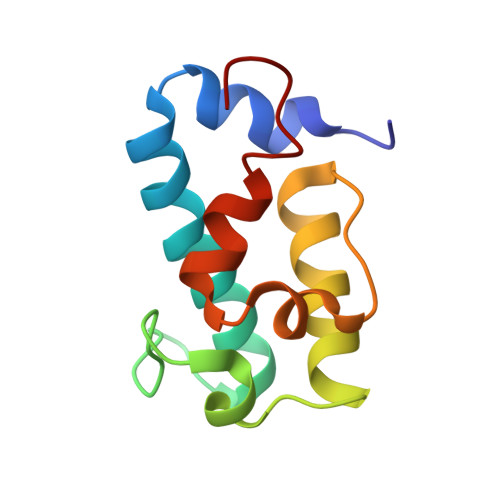Modular type I polyketide synthase acyl carrier protein domains share a common N-terminally extended fold.
Moretto, L., Heylen, R., Holroyd, N., Vance, S., Broadhurst, R.W.(2019) Sci Rep 9: 2325-2325
- PubMed: 30787330
- DOI: https://doi.org/10.1038/s41598-019-38747-9
- Primary Citation of Related Structures:
6H0J, 6H0Q - PubMed Abstract:
Acyl carrier protein (ACP) domains act as interaction hubs within modular polyketide synthase (PKS) systems, employing specific protein-protein interactions to present acyl substrates to a series of enzyme active sites. Many domains from the multimodular PKS that generates the toxin mycolactone display an unusually high degree of sequence similarity, implying that the few sites which vary may do so for functional reasons. When domain boundaries based on prior studies were used to prepare two isolated ACP segments from this system for studies of their interaction properties, one fragment adopted the expected tertiary structure, but the other failed to fold, despite sharing a sequence identity of 49%. Secondary structure prediction uncovered a previously undetected helical region (H0) that precedes the canonical helix-bundle ACP topology in both cases. This article reports the NMR solution structures of two N-terminally extended mycolactone mACP constructs, mH0ACPa and mH0ACPb, both of which possess an additional α-helix that behaves like a rigid component of the domain. The interactions of these species with a phosphopantetheinyl transferase and a ketoreductase domain are unaffected by the presence of H0, but a shorter construct that lacks the H0 region is shown to be substantially less thermostable than mH0ACPb. Bioinformatics analysis suggests that the extended H0-ACP motif is present in 98% of type I cis-acyltransferase PKS chain-extension modules. The polypeptide linker that connects an H0-ACP motif to the preceding domain must therefore be ~12 residues shorter than previously thought, imposing strict limits on ACP-mediated substrate delivery within and between PKS modules.
Organizational Affiliation:
Department of Chemistry and Biomedical Sciences, Linnaeus University, Smålandsgatan-24, 392 34, Kalmar, Sweden.














